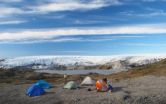(Press-News.org) Some of the landscape underlying the massive Greenland ice sheet may have been undisturbed for almost 3 million years, ever since the island became completely ice-covered, according to researchers funded by the National Science Foundation (NSF).
Basing their discovery on an analysis of the chemical composition of silts recovered from the bottom of an ice core more than 3,000 meters long, the researchers argue that the find suggests "pre-glacial landscapes can remain preserved for long periods under continental ice sheets."
In the time since the ice sheet formed "the soil has been preserved and only slowly eroded, implying that an ancient landscape underlies 3,000 meters of ice at Summit, Greenland," they conclude.
They add that "these new data are most consistent with [the concept of] a continuous cover of Summit… by ice … with at most brief exposure and minimal surface erosion during the warmest or longest interglacial [periods]."
They also note that fossils found in northern Greenland indicated there was a green and forested landscape prior to the time that the ice sheet began to form. The new discovery indicates that even during the warmest periods since the ice sheet formed, the center of Greenland remained stable, allowing the landscape to be locked away, unmodified, under ice through millions of years of cyclical warming and cooling.
"Rather than scraping and sculpting the landscape, the ice sheet has been frozen to the ground, like a giant freezer that's preserved an antique landscape", said Paul R. Bierman, of the Department of Geology and Rubenstein School of the Environment and Natural Resources at the University of Vermont and lead author of the paper.
Bierman's work was supported by two NSF grants made by its Division of Polar Programs, 1023191 and 0713956. Thomas A. Neumann, also of the University of Vermont, but now at NASA's Goddard Space Flight Center, a co-author on the paper, also was a co-principal investigator on the latter grant.
Researchers from Idaho State University, the University of California, Santa Barbara, and the Scottish Universities Environmental Research Centre at the University of Glasgow also contributed to the paper.
The research also included contributions from two graduate students, both supported by NSF, one of whom was supported by the NSF Graduate Research Fellowships Program.
The team's analysis was published on line on April 17 and will appear in Science magazine the following week.
Understanding how Greenland's ice sheet behaved in the past, and in particular, how much of the ice sheet melted during previous warm periods as well as how it re-grew is important to developing a scientific understanding of how the ice sheet might behave in the future.
As global average temperatures rise, scientists are concerned about how the ice sheets in Greenland and Antarctica will respond. Vast amounts of freshwater are stored in the ice and may be released by melting, which would raise sea levels, perhaps by many meters.
The magnitude and rate of sea level rise are unknown factors in climate models.
The team based its analysis on material taken from the bottom of an ice core retrieved by the NSF-funded Greenland Ice Sheet Project Two (GISP2), which drilled down into the ice sheet near NSF's Summit Station. An ice core is a cylinder of ice in which individual layers of ice, compacted from snowfall, going back over millennia can be observed and sampled.
Summit is situated at an elevation of 3,216 meters (10,551 feet) above sea level.
In the case of GISP2, the core itself, taken from the center of the present-day Greenland ice sheet, was 3,054 meters (10,000 feet) deep. It provides a history of the balance of gases that made up the atmosphere at time the snow fell as well as movements in the ice sheet stretching back more than 100,000 years. It also contains a mix of silts and sediments at its base where ice and rock come together.
The scientists looked at the proportions of the elements carbon, nitrogen and Beryllium-10, the source of which is cosmic rays, in sediments taken from the bottom 13 meters (42 feet) of the GISP2 ice core.
They also compared levels of the various elements with soil samples taken in Alaska, leading them to the conclusion that the landscape under the ice sheet was indeed an ancient one that predates the advent of the ice sheet. The soil comparisons were supported by two NSF grants: 0806394 and 0806399.
INFORMATION:
-NSF-
Frozen in time: 3-million-year-old landscape still exists beneath the Greenland ice sheet
NSF-funded researchers say the massive ice sheet has fixed the landscape in place, rather than scouring it away
2014-04-18
ELSE PRESS RELEASES FROM THIS DATE:
Impact glass stores biodata for millions of years
2014-04-18
PROVIDENCE, R.I. [Brown University] — Asteroid and comet impacts can cause widespread ecological havoc, killing off plants and animals on regional or even global scales. But new research from Brown University shows that impacts can also preserve the signatures of ancient life at the time of an impact.
A research team led by Brown geologist Pete Schultz has found fragments of leaves and preserved organic compounds lodged inside glass created by a several ancient impacts in Argentina. The material could provide a snapshot of environmental conditions at the time of those ...
'Dressed' laser aimed at clouds may be key to inducing rain, lightning
2014-04-18
The adage "Everyone complains about the weather but nobody does anything about it," may one day be obsolete if researchers at the University of Central Florida's College of Optics & Photonics and the University of Arizona further develop a new technique to aim a high-energy laser beam into clouds to make it rain or trigger lightning.
The solution? Surround the beam with a second beam to act as an energy reservoir, sustaining the central beam to greater distances than previously possible. The secondary "dress" beam refuels and helps prevent the dissipation of the high-intensity ...
First Earth-size planet is discovered in another star's habitable zone
2014-04-18
A team of astronomers that includes Penn State scientists has discovered the first Earth-size planet orbiting a star in the "habitable zone" -- the distance from a star where liquid water might pool on the surface of an orbiting planet. The discovery was made with NASA's Kepler Space Telescope. The discovery of this Earth-size planet, now named Kepler-186f, confirms -- for the first time -- that planets the size of Earth exist in the habitable zone of stars other than our Sun.
Some planets previously had been found in the habitable zone, but they all were at least 40 ...
Scientists discover brain's anti-distraction system
2014-04-18
Two Simon Fraser University psychologists have made a brain-related discovery that could revolutionize doctors' perception and treatment of attention-deficit disorders.
This discovery opens up the possibility that environmental and/or genetic factors may hinder or suppress a specific brain activity that the researchers have identified as helping us prevent distraction.
The Journal of Neuroscience has just published a paper about the discovery by John McDonald, an associate professor of psychology and his doctoral student John Gaspar, who made the discovery during his ...
New research shows people are thinking about their health early in the week
2014-04-18
San Diego, Calif. (April 18, 2014) ― A new study in the American Journal of Preventive Medicine analyzing weekly patterns in health-related Google searches reveals a recurring pattern that could be leveraged to improve public health strategies.
Investigators from San Diego State University, the Santa Fe Institute, Johns Hopkins University, and the Monday Campaigns, analyzed "healthy" Google searches (searches that included the term healthy and were indeed health-related, e.g., "healthy diet") originating in the U.S. from 2005 to 2012. They found that on average, ...
New clues on tissue scarring in scleroderma
2014-04-18
A discovery by Northwestern Medicine scientists could lead to potential new treatments for breaking the cycle of tissue scarring in people with scleroderma.
Fibrosis, or scarring, is a hallmark of the disease, and progressive tightening of the skin and lungs can lead to serious organ damage and, in some cases, death.
The concept for new therapeutic options centers on findings made by Swati Bhattacharyya, PhD, research assistant professor in Medicine-Rheumatology, who identified the role that a specific protein plays in promoting fibrosis.
"Our results show how a ...
Pizza Maker - Cooking Games Made by Wizards Time LLC Now for iOS
2014-04-18
Wizards Time LLC announced that Pizza Maker - Cooking Games, cooking game for kids, is now ready for free download on iTunes. The game which is in the category of educational games, has made more than 50 000 downloads on Google Play Store. Due to the success, this game is now available to iOS users as well.
Pizza Maker is an educational and interactive game for kids made of three mini games. First of all, kids are to make pizza as similar as possible to the one given as a task. Users will have different ingredients for making and decorating pizzas. Also, users have ...
The Master Shift Presents-Earth Day Meditation Narrated By Julian Lennon, April 22, 2014
2014-04-18
The Master Shift provides Global meditations to uplift humanity using the power of positive focused thought. The meditations raise vibrational energy where spiritual healing is needed around the globe.
The world is invited to join in meditation for our planet on April 22, 2014. The Master Shift has fashioned an online guided meditation that will be narrated by Julian Lennon. Lennon, who has the same charismatic environmentalist approach as his father, has focused on how he can do his part and embrace the humanitarian issues that plague the planet. The meditation event ...
Ft Greene Sweetery Makes it Easy For Everyone To Pay It Forward!
2014-04-18
Brooklyn Sweet Spot announces the launch of their Random Acts of Sweetness Campaign. From April 18, 2014 - April 24, 2014 Brooklyn Sweet Spot is extending the sweetness beyond 366 Myrtle Avenue, with the launch of their Random Acts of Sweetness Campaign. Brooklyn Sweet Spot is providing participating Myrtle Avenue merchants with complimentary cupcakes to be "paid forward" to customers. The only string attached is customers must be willing to pass the random act of sweetness on and give the sweet treat to someone else, preferably a stranger.
April 24, 2014 marks National ...
Are Your Employees Helping Grow Your Dog Daycare?
2014-04-18
Pet care is a multimillion dollar industry, which thrived even during America's most recent recession. Dog daycares make up a large part of that industry. Nikki Ivey of DogSpeak has created an in-depth course for dog daycare staff to become certified supervisors.
The purpose of the certification is to not only train daycare staff to understand dog language and communication, but also aims to help business owners generate more business.
"Proper staff training is imperative to not only ensure dog daycares are safe environments, but also to ensure appropriate behaviors ...
LAST 30 PRESS RELEASES:
New software sheds light on cancer’s hidden genetic networks
UT Health San Antonio awarded $3 million in CPRIT grants to bolster cancer research and prevention efforts in South Texas
Third symposium spotlights global challenge of new contaminants in China’s fight against pollution
From straw to soil harmony: International team reveals how biochar supercharges carbon-smart farming
Myeloma: How AI is redrawing the map of cancer care
Manhattan E. Charurat, Ph.D., MHS invested as the Homer and Martha Gudelsky Distinguished Professor in Medicine at the University of Maryland School of Medicine
Insilico Medicine’s Pharma.AI Q4 Winter Launch Recap: Revolutionizing drug discovery with cutting-edge AI innovations, accelerating the path to pharmaceutical superintelligence
Nanoplastics have diet-dependent impacts on digestive system health
Brain neuron death occurs throughout life and increases with age, a natural human protein drug may halt neuron death in Alzheimer’s disease
SPIE and CLP announce the recipients of the 2025 Advanced Photonics Young Innovator Award
Lessons from the Caldor Fire’s Christmas Valley ‘Miracle’
Ant societies rose by trading individual protection for collective power
Research reveals how ancient viral DNA shapes early embryonic development
A molecular gatekeeper that controls protein synthesis
New ‘cloaking device’ concept to shield sensitive tech from magnetic fields
Researchers show impact of mountain building and climate change on alpine biodiversity
Study models the transition from Neanderthals to modern humans in Europe
University of Phoenix College of Doctoral Studies releases white paper on AI-driven skilling to reduce burnout and restore worker autonomy
AIs fail at the game of visual “telephone”
The levers for a sustainable food system
Potential changes in US homelessness by ending federal support for housing first programs
Vulnerability of large language models to prompt injection when providing medical advice
Researchers develop new system for high-energy-density, long-life, multi-electron transfer bromine-based flow batteries
Ending federal support for housing first programs could increase U.S. homelessness by 5% in one year, new JAMA study finds
New research uncovers molecular ‘safety switch’ shielding cancers from immune attack
Bacteria resisting viral infection can still sink carbon to ocean floor
Younger biological age may increase depression risk in older women during COVID-19
Bharat Innovates 2026 National Basecamp Showcases India’s Most Promising Deep-Tech Ventures
Here’s what determines whether your income level rises or falls
SCIE indexation achievement: Celebrate with Space: Science & Technology
[Press-News.org] Frozen in time: 3-million-year-old landscape still exists beneath the Greenland ice sheetNSF-funded researchers say the massive ice sheet has fixed the landscape in place, rather than scouring it away




